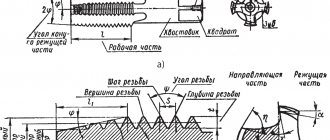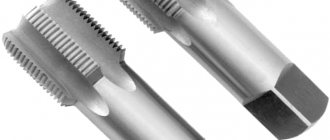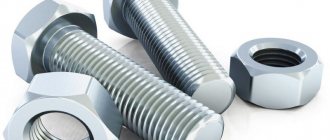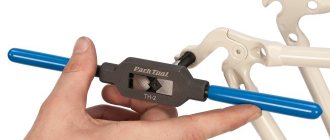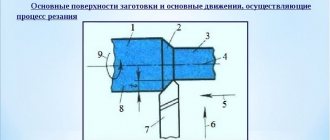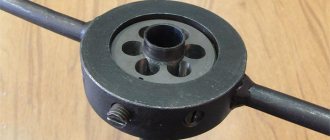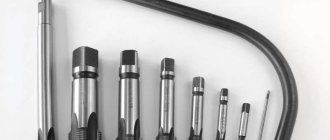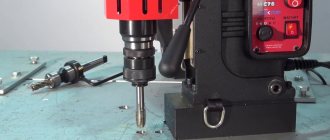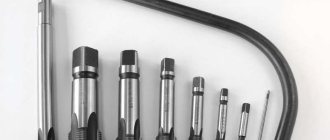How to choose a thread tap
Next, we'll tell you how to choose a tap for threading. The process takes into account the main characteristics:
- diameter measurement system (inch, metric);
- number of tool passes (one, two, three);
- profile shape (rectangular, trapezoidal, triangular);
- the side in which the screw rotates (left, right);
- placement of threads on the part (inside, outside);
- shape of the part (cone-shaped, cylindrical).
If single products are mainly used to correct broken threads, then sets are used to create a new one. In them, the types of taps for threading are defined as rough, medium and finishing.
Image #3: Standard three-tool tap set
The first is intended for cutting a rough thread, the second for deepening it, the third for finishing it to its final (finish) form. To distinguish one product from the rest in the set, pay attention to the shape of the marks on the tail parts.
- The first tap has the tooth tips cut off and has a smaller outer diameter than the rest of the tools in the set.
- The second one has short tooth segments and has elongated ridges. The diameter of the middle tap is slightly larger than the finishing one.
- The third has a full ridge of teeth and matches the diameter of the future thread.
When calculating the future diameter of the hole, the formula is useful:
Hole D = Tap D * 0.8
Next, when choosing, refer to the table.
Table No. 3: Correspondence between thread diameters and preparation holes
Taps for threading: types, size tables, GOST requirements
You can make a thread in a finished metal hole or nut in literally seconds if you have a tap. Using this metal-cutting tool, you can apply internal threads and calibrate existing ones.
Of course, taps are not the only tool used to create threads. For example, dies and blanks fall into a similar category. They are used to apply threads to the outside of a part. But that’s not about that now.
There are quite a few types of taps; experienced craftsmen have never even heard of some of them. Therefore, we will leave the specific types of this tool to highly specialized specialists and analyze the most popular ones.
Let's try to choose a tool for specific needs. Using the algorithm presented below, this will not be difficult to do.
Step 1. Application areas: home workshop or production
Obviously, when working at home and in production, the master will need different tools.
Hand taps
(they are also locksmiths) can be found in any workshop. Due to its significant strength and wear resistance, the tool allows you to perform high-precision work even in domestic conditions. They are usually equipped with a special crank necessary to rotate the tap.
Hand taps are almost always sold in sets of 2-3 pieces of various diameters. Each tool performs its task: one performs rough thread processing, the second (if any) does intermediate processing, the third does finishing, after which the profile meets all GOST standards (more on them below).
But hand taps are not designed to operate at high rotation speeds. For this, machine analogues are used.
Machine taps
Made from higher quality high-speed steel, which can easily withstand the severe heat that occurs due to friction and cutting metal. It is in terms of strength that metalworking taps are inferior to their machine counterparts. In addition, machine tools have a small intake part, because The alignment of the tap and the workpiece hole is ensured by the design of the machine.
There is also a third type of taps - nut
. It is easy to guess that they are used exclusively for threading nuts.
Nut taps have a long shank, which is installed in a special automatic machine. After the threads are applied, the nuts are moved one by one to the tail section and wait there until the entire series is completed. The tap is then removed from the chuck and all nuts are dumped into the receiving tray. This significantly saves operating time and increases productivity.
Step 2. Hole type: blind or through
The purpose of your work is of no small importance: are you going to create a profile in a blind hole or a through hole? Depending on this, you will need different tools. In particular, the chip flutes on the tap will play an important role. They can twist (both to the left and to the right), or they can be positioned straight.
Straight-line
grooves are used in universal taps.
Tools with right groove recess
More often used to create a profile in blind holes. Along these grooves, the chips are squeezed back outward and do not clog the hole.
Left-directed helical grooves
used to create a profile in through holes. The chips are forced out directly in front of the tap, thereby protecting the newly applied threads from damage.
There is also an option for taps with shorter flutes, known as fluteless taps.
, or raskatniki. This design helps create threads in products made from ductile materials, for example, alloyed high-strength and low-carbon ductile steels, as well as aluminum alloys.
Step 3: Thread Type
In production, there are several state standards that differ in the measurement system. Using the markings on the tap, you can understand which of them the tool belongs to - metric or inch. Based on the type of tap device, three types of threads can be applied.
Metric thread
Metric taps are useful for creating a profile whose dimensions are measured in millimeters. They are marked with the symbol “M”.
The profile of taps of this type is an isosceles triangle with an apex angle of 60°.
The size range of metric taps is quite extensive - with their help you can create almost any profile. Each tap size has its own main pitch - the distance between the threads. The larger the size, the larger the main step. To select a tool, a special table is used based on state standards (according to GOST 19257-73).
Inch thread
Unlike metric ones, the size of inch taps is indicated in inches. This system came to us from abroad. In particular, from the USA and Great Britain.
The main pitch is indicated by the number of threads (or number of turns) per 1 inch. The higher the number, the finer the thread pitch.
The vertex angle in inch threads can be different. The 60° angle is typical for taps common in North America. UNC thread has gained maximum popularity. Such fasteners are often found on equipment imported to Russia (lawn mowers, generators, cultivators, etc.).
British standard BSW inch threads have a tip angle of 55°.
Below are the inch sizes of taps of the most popular standards.
Pipe thread
Among inch taps, it is worth highlighting a group of tools used to create a profile in pipe connections. Pipe threads are especially common in elements of water supply systems.
The dimensions of the pipe taps are specially adjusted to standard types of metal pipes. They are divided into cylindrical
and
conical
. The first ones are designated by the letter “G”, followed by a number corresponding to the bore diameter. Tapered pipe taps are marked with the symbols “R” or “Rc”. The thread is applied to the surface with a taper of 1:16 and reaches the stop.
Traditionally, their sizes are indicated in inches. However, over time, the designation system has lost its identity with the actual dimensions, so tools for pipe threads are selected according to tables (based on GOST 6357-81 and GOST 6111-81).
GOST requirements
State standards determine the requirements for the dimensions and characteristics of taps, and also introduce maximum tolerances, accuracy class and degree of surface roughness. Almost all indicators for the choice and quality of threads are regulated by GOST 3266-81, which you can.
Design features
The first tools for cutting internal threads were distinguished by a primitive design and consisted of a tetrahedral rod, at the working end of which, sharpened to a shallow cone, cutting teeth were sawn out. When using such a tap, the thread was cut by screwing it into the inside of the nut or into a previously prepared hole in the workpiece. Naturally, such a tool had many disadvantages, the most significant of which include the absence of a rear surface on the cutting part, as well as a negative rake angle. Over time, the design of taps has become more sophisticated, and today they allow you to create accurate and high-quality internal threads.
Any tap for cutting threads on the internal surfaces of workpieces, regardless of its geometric parameters and purpose, contains the following elements:
- side grooves (there can be from 2 to 6);
- conical intake part;
- calibrating part, which has a cylindrical shape.
Tap design
The grooves located on the side surface of the tool along its entire length simultaneously perform two functions: ensuring the removal of chips from the processing zone and facilitating the supply of coolant lubricant (coolant) to such a zone. The shape that the groove of the tap has in cross section is determined by its two surfaces, one of which is the front edge of the cutting tooth of the tool, and the second is its back. Depending on the type of profile, chip flutes are of the following types:
- single-radius (with grooves of this shape, mainly calibration type taps are produced);
- with straight front and back surfaces (tools with grooves of this shape are used for cutting threads inside nuts);
- with a straight front and radius back surfaces (most taps are manufactured with this type of flute).
Tap flute profiles
The grooves can be located in different ways: there are straight grooves, as well as spiral right or left. Universal taps for general use are manufactured with straight-type grooves. Spiral left-handed flutes produce taps used for cutting threads for passages. The chips created by such a tool move ahead of it along the hole being processed, thereby eliminating the risk of damage to the already cut thread. When using taps with the right direction of twisting of the grooves, the chips are removed from the processing zone to the tool shank. For this reason, right-handed taps are ideal for cutting threads in blind holes.
The intake part of the tap, as mentioned above, has a conical shape, which facilitates the process of inserting the tool into the hole being machined. The specific value of the angle of inclination of the intake part, which can be in the range of 3–20°, is selected depending on what type of processing the tool will be used for - roughing, intermediate or finishing.
Tap designs according to GOST
The cylindrical calibration part is made with a reverse reduction of up to 0.1 mm, which is necessary in order to reduce the friction forces arising during the thread cutting process. The friction force between the working part of the tap and the machined surface can also be reduced by backing the back surface of the cutting teeth, carried out from their top to 1/3 of their width. This creates a reduction in the back surface of the cutting teeth, the value of which for tools with a diameter of 12–30 mm is about 0.1 mm.
Geometry of the cutting and calibrating part of the tap
